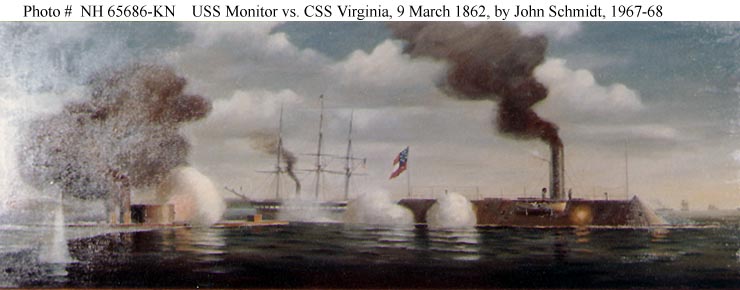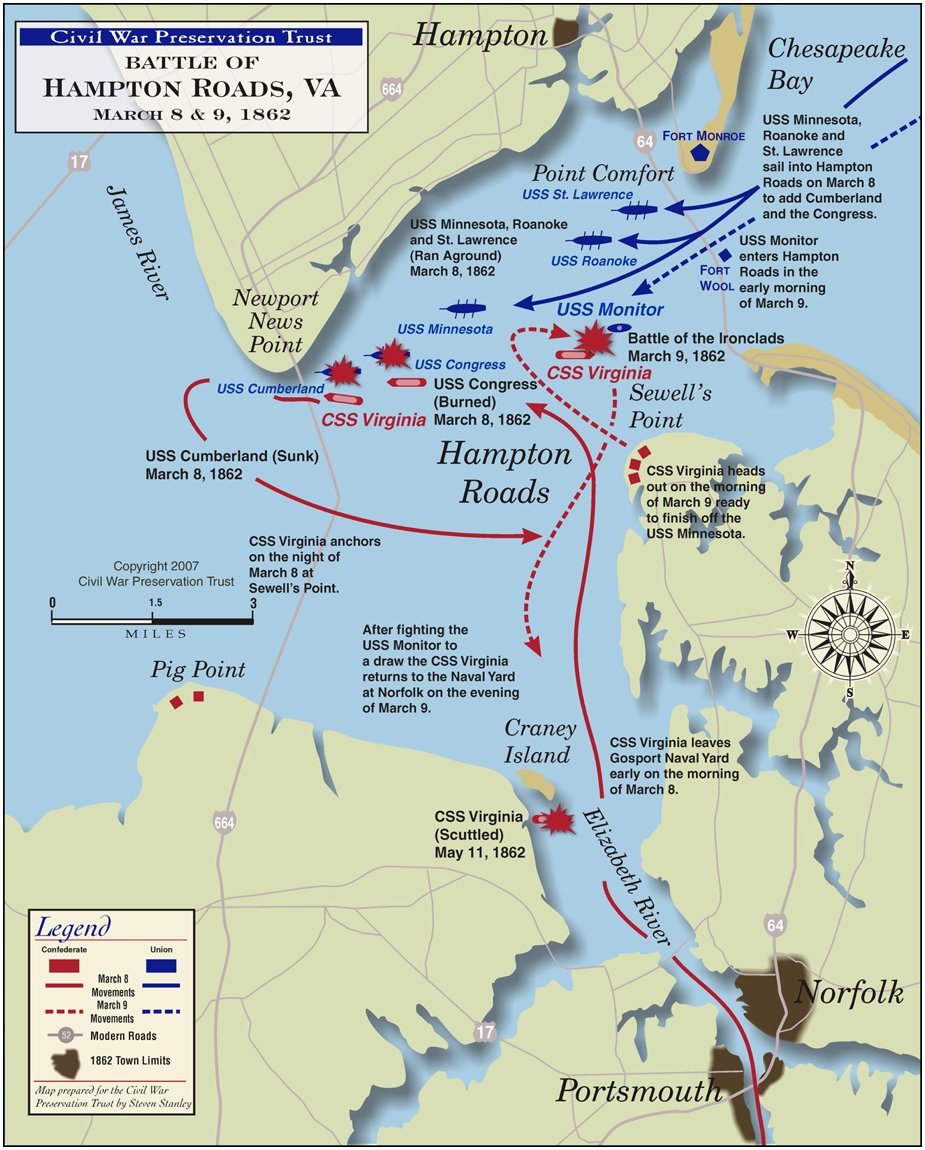|
Battle of USS Monitor and CSS Virginia, 9 March 1862
At dawn on 9 March 1862, CSS Virginia (CSS Virginia (formerly USS Merrimack): Homepage) prepared for renewed combat. The previous day, she had utterly defeated two
big Federal warships, Congress and Cumberland, destroying both and killing more than 240 of their crewmen (see CSS Virginia destroys USS Cumberland
and USS Congress). Today, she expected to inflict a similar fate on the grounded steam frigate
Minnesota and other enemy ships, probably freeing the lower Chesapeake Bay region of Union seapower and the land forces
it supported. Virginia would thus contribute importantly to the Confederacy's military, and perhaps diplomatic, fortunes.
| USS Monitor vs. CSS Virginia, 9 March 1862 |

|
| Courtesy of the Marine Midland National Bank (U.S. Naval Historical Center Photograph) |
However, as they surveyed the opposite side of Hampton Roads, where
the Minnesota and other potential victims awaited their fate, the Confederates realized that things were not going
to be so simple. There, looking small and low near the lofty frigate, was a vessel that
could only be USS Monitor (USS Monitor: Homepage), the Union Navy's own ironclad, which had arrived the previous evening
after a perilous voyage from New York. Though her crew was exhausted and their ship untested, the Monitor was
also preparing for action.
Undeterred, Virginia steamed out into Hampton Roads. Monitor
positioned herself to protect the immobile Minnesota, and a general battle began. Both ships hammered away at each
other with heavy cannon, and tried to run down and hopefully disable the other, but their iron-armored sides prevented vital
damage. Virginia's smokestack was shot away, further reducing her already modest mobility, and Monitor's technological
teething troubles hindered the effectiveness of her two eleven-inch guns, the Navy's most powerful weapons. Ammunition supply
problems required her to temporarily pull away into shallower water, where the deep-drafted Virginia could not follow,
but she always covered the Minnesota.
| Monitor Merrimack Battle of Hampton Roads Map |

|
| Map of Monitor Virginia Battle, aka Monitor Merrimack Battle |
Soon after noon, Virginia gunners concentrated their fire on Monitor's
pilothouse, a small iron blockhouse near her bow. A shell, that hit there, blinded Lieutenant John L. Worden, the Union ship's Commanding Officer, forcing another withdrawal until he could be
relieved at the conn. By the time she was ready to return to the fight, Virginia had turned away toward Norfolk.
The first battle between ironclad warships had ended in stalemate, a situation
that lasted until Virginia's self-destruction two months later. However, the outcome of combat between armored equals,
compared with the previous day's terrible mis-match, symbolized the triumph of industrial age warfare. The value of existing
ships of the line and frigates was heavily discounted in popular and professional opinion. Ironclad construction programs,
already underway in America and Europe, accelerated. The resulting armored warship competition would continue into the 1940s,
some eight decades in the future.
Reference: Department of the Navy, Naval History & Heritage Command,
805 Kidder Breese SE, Washington Navy Yard, Washington D.C., 20374-5060
Recommended
Reading: Ironclad Down: USS Merrimack-CSS Virginia from Design to Destruction (Hardcover). Description: The result of more than fifteen years
of research, Ironclad Down is a treasure trove of detailed information about one of history s most famous vessels. Describing
the fascinating people--Stephen Russell Mallory, John Mercer Brooke, John Luke Porter, et al.--who conceived, designed and
built one of the world's first ironclads as well as describing the ship itself, Carl Park offers both the most thoroughly
detailed, in-depth analysis to date of the actual architecture of the Virginia
and a fascinating, colorful chapter of Civil War history.
Recommended
Reading: Confederate Ironclad vs Union Ironclad: Hampton Roads
1862 (Duel). Description: The Ironclad
was a revolutionary weapon of war. Although iron was used for protection in the Far East
during the 16th century, it was the 19th century and the American Civil War that heralded the first modern armored self-propelled
warships. With the parallel pressures of civil war and the industrial revolution, technology advanced at a breakneck speed.
It was the South who first utilized ironclads as they attempted to protect their ports from the Northern blockade. Impressed
with their superior resistance to fire and their ability to ram vulnerable wooden ships, the North began to develop its own
rival fleet of ironclads. Eventually these two products of this first modern arms race dueled at the battle of Hampton Roads
in a clash that would change the face of naval warfare. Continued below…
Fully illustrated
with cutting-edge digital artwork, rare photographs and first-person perspective gun sight views, this book allows the reader
to discover the revolutionary and radically different designs of the two rival Ironclads - the CSS Virginia and USS Monitor
- through an analysis of each ship's weaponry, ammunition and steerage. Compare the contrasting training of the crews and
re-live the horrors of the battle at sea in a war which split a nation, communities and even families. About the Author: Ron
Field is Head of History at the Cotswold School in
Bourton-on-the-Water. He was awarded a Fulbright Scholarship in 1982 and taught history at Piedmont
High School in California
from 1982 to 1983. He was associate editor of the Confederate Historical Society of Great Britain, from 1983 to 1992. He is
an internationally acknowledged expert on US Civil War military history, and was elected a Fellow of the Company of Military
Historians, based in Washington, DC,
in 2005. The author lives in Cheltenham, UK.
Recommended
Reading: Reign of Iron: The Story of the First Battling Ironclads, the Monitor
and the Merrimack. From Publishers Weekly: The Monitor-Merrimack showdown may be one of the Civil War’s
most overhyped chestnuts: the two ships were by no means the first ironclads, and their long awaited confrontation proved
an anticlimactic draw, their cannon fire clanging harmlessly off each other’s hulls. Still, the author of this lively
history manages to bring out the story’s dramatic elements. Nelson, author of the Revolution at Sea series of age-of-sail
adventure novels, knows how to narrate a naval crisis. He gives a harrowing account of the Merrimack’s initial onslaught, in which it destroyed two wooden Union warships in a
bloody and chaotic battle the day before the Monitor arrived, and of the Monitor’s nightmarish final hours as it foundered
in a storm at sea. Continued below…
Equally arresting
is his retelling of the feverish race between North and South to beat the other side to the punch with their respective wonder
ships. He delves into every aspect of the ships’ innovative design and construction, and draws vivid portraits of the
colorful characters who crafted them, especially the brilliant naval architect John Ericsson, one of that epic breed of engineer-entrepreneurs
who defined the 19th century. The resulting blend of skillful storytelling and historical detail will please Civil War and
naval engineering buffs alike.
Recommended
Reading: The Battle of Hampton
Roads: New Perspectives on the USS Monitor and the CSS Virginia (Mariner's Museum). Description: On March 8 and 9, 1862, a sea battle off the Virginia coast changed naval warfare forever. It began when the Confederate States Navy’s
CSS Virginia led a task force to break the Union blockade of Hampton Roads. The Virginia
sank the USS Cumberland and forced the frigate Congress to surrender. Damaged by shore batteries, the Virginia retreated, returning the next day to find her way blocked by the newly arrived
USS Monitor. The clash of ironclads was underway. Continued below…
After fighting
for nine hours, both ships withdrew, neither seriously damaged, with both sides claiming victory. Although the battle may
have been a draw and the Monitor sank in a storm later that year, this first encounter between powered, ironclad warships
spelled the end of wooden warships—and the dawn of a new navy. This book takes a new look at this historic battle. The
ten original essays, written by leading historians, explore every aspect of the battle—from the building of the warships
and life aboard these “iron coffins” to tactics, strategy, and the debates about who really won the battle of
Hampton Roads. Co-published with The Mariners’ Museum, home to the USS Monitor Center, this authoritative guide to the
military, political, technological, and cultural dimensions of this historic battle also features a portfolio of classic lithographs,
drawings, and paintings. Harold Holzer is one of the country’s leading experts on the Civil War.
Recommended
Reading: Iron Afloat: The Story of the Confederate Armorclads. Description: William N. Still's book is rightfully referred to as the standard of Confederate Naval history.
Accurate and objective accounts of the major and even minor engagements with Union forces are combined with extensive background
information. This edition has an enlarged section of historical drawings and sketches. Mr. Still explains the political background
that gave rise to the Confederate Ironclad program and his research is impeccable. An exhaustive literature listing rounds
out this excellent book. While strictly scientific, the inclusion of historical eyewitness accounts and the always fluent
style make this book a joy to read. This book is a great starting point.
Recommended
Reading: A History of Ironclads: The Power of Iron over Wood. Description: This
landmark book documents the dramatic history of Civil War ironclads and reveals how ironclad warships revolutionized naval
warfare. Author John V. Quarstein explores in depth the impact of ironclads during the Civil War and their colossal effect
on naval history. The Battle of Hampton Roads was one of history's greatest naval engagements. Over the course of two days
in March 1862, this Civil War conflict decided the fate of all the world's navies. It was the first battle between ironclad
warships, and the 25,000 sailors, soldiers and civilians who witnessed the battle vividly understood what history would soon
confirm: wars waged on the seas would never be the same. Continued below…
About the Author: John V. Quarstein is an award-winning author and historian. He is director
of the Virginia
War Museum in Newport News and chief historical advisor for The Mariners' Museum's new USS Monitor Center
(opened March 2007). Quarstein has authored eleven books and dozens of articles on American, military and Civil War history,
and has appeared in documentaries for PBS, BBC, The History Channel and Discovery Channel.
|

